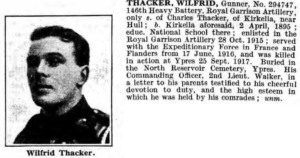 Gunner, Wilfred Thacker served in the Royal Garrison Artillery. Wilfred was born in Kirk Ella on the 2nd April 1895. Son Charles and Jane Thacker. He enlisted on 28th October 1915 and was killed in action, on the 25th September 1917. He formally served with the 146th Hull Heavy Battery Royal Garrison Artillery Regiment. In 1911, Wilfred was an only son and lived with his parents Charles and Jane in Kirk Ella and he was employed as a Stationary Engine Stoker on the Docks. The Royal Garrison Artillery (RGA) was an arm of the Royal Artillery that was originally tasked with manning the guns of the British Empire’s forts and fortresses, including coastal artillery batteries, the heavy gun batteries attached to each infantry division, and the guns of the siege artillery. With the new long-range small arms available to the infantry in the era before World War I, artillery fighting in the infantry line was increasingly brought under fire. The solution to this was the principle of standing off and engaging the enemy with indirect fire. However, even after this became official military doctrine, field and horse artillery on both sides kept trying to fight in the old way. One instance was a gun duel fought between British and German horse artillery units using open sights during the Retreat to the Marne.[6] In the quagmire of trench warfare that followed it was finally realised that it was not the place for the artillery to be in the infantry line. Henceforth the artillery would be positioned well behind the infantry battle line, firing at unseen targets, at co-ordinates on a map calculated with geometry and mathematics. As the war developed, the heavy artillery and the techniques of long-range artillery were massively developed. The RGA was often supported by the Royal Flying Corps (RFC) who had devised a system where pilots could use wireless telegraphy to help the artillery hit specific targets. The RFC aircraft carried a wireless set and a map and after identifying the position of an enemy target the pilot was able to transmit messages such as A5, B3, etc. in morse code to a RFC land station attached to a heavy artillery units, such as Royal Garrison Artillery Siege Batteries. The Siege batteries (such as 9th Siege Battery at the Battle of the Somme) had the largest guns and howitzers; mounted on railways or on fixed concrete emplacements. Ammunition supply to the Royal Field Artillery (RFA) and other field artillery units was normally the role of the Royal Artillery: that part of the Royal Regiment of Artillery which retained the Royal Artillery (RA) shoulder badges. However, during the war the RGA, which had large numbers of men idling in fortified batteries around the World with little chance of seeing action, provided a draft of sub-units to the Western Front to assist with ammunition supply in the field, and the operation of supply dumps.
Gunner, Wilfred Thacker served in the Royal Garrison Artillery. Wilfred was born in Kirk Ella on the 2nd April 1895. Son Charles and Jane Thacker. He enlisted on 28th October 1915 and was killed in action, on the 25th September 1917. He formally served with the 146th Hull Heavy Battery Royal Garrison Artillery Regiment. In 1911, Wilfred was an only son and lived with his parents Charles and Jane in Kirk Ella and he was employed as a Stationary Engine Stoker on the Docks. The Royal Garrison Artillery (RGA) was an arm of the Royal Artillery that was originally tasked with manning the guns of the British Empire’s forts and fortresses, including coastal artillery batteries, the heavy gun batteries attached to each infantry division, and the guns of the siege artillery. With the new long-range small arms available to the infantry in the era before World War I, artillery fighting in the infantry line was increasingly brought under fire. The solution to this was the principle of standing off and engaging the enemy with indirect fire. However, even after this became official military doctrine, field and horse artillery on both sides kept trying to fight in the old way. One instance was a gun duel fought between British and German horse artillery units using open sights during the Retreat to the Marne.[6] In the quagmire of trench warfare that followed it was finally realised that it was not the place for the artillery to be in the infantry line. Henceforth the artillery would be positioned well behind the infantry battle line, firing at unseen targets, at co-ordinates on a map calculated with geometry and mathematics. As the war developed, the heavy artillery and the techniques of long-range artillery were massively developed. The RGA was often supported by the Royal Flying Corps (RFC) who had devised a system where pilots could use wireless telegraphy to help the artillery hit specific targets. The RFC aircraft carried a wireless set and a map and after identifying the position of an enemy target the pilot was able to transmit messages such as A5, B3, etc. in morse code to a RFC land station attached to a heavy artillery units, such as Royal Garrison Artillery Siege Batteries. The Siege batteries (such as 9th Siege Battery at the Battle of the Somme) had the largest guns and howitzers; mounted on railways or on fixed concrete emplacements. Ammunition supply to the Royal Field Artillery (RFA) and other field artillery units was normally the role of the Royal Artillery: that part of the Royal Regiment of Artillery which retained the Royal Artillery (RA) shoulder badges. However, during the war the RGA, which had large numbers of men idling in fortified batteries around the World with little chance of seeing action, provided a draft of sub-units to the Western Front to assist with ammunition supply in the field, and the operation of supply dumps.
His details are listed in the De Ruvigny Roll of Honour, Volume 4. He is buried at Ypres Reservoir Cemetery. He is commemorated on the Kirkella War Memorial.
| Name | Wilfrid Thacker |
|---|---|
| Buried | Ypres Reservoir Cemetery, West Vlaanderen, Belgium |
| Rank | Gunner |
| Regimental Number | 294747 |
| Regiment or Ship | Royal Garrison Artillery |
| Birth Date | 2 Apr 1895 |
| Birth Place | Kirkella, Hull |
| Enlistment Date | 28 Oct 1915 |
| Death Date | 25 Sep 1917 |
| Death Place | Ypres |
| Father | Charles Thacker |
| Volume | Volume 4, UK, De Ruvigny’s Roll of Honour, 1914-1919 |

